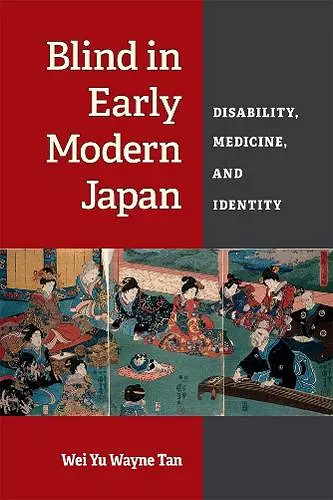Blind in Early Modern Japan
Disability, Medicine, and Identity
Format:Paperback
Publisher:The University of Michigan Press
Published:6th Sep '22
Should be back in stock very soon

While the loss of sight—whether in early modern Japan or now—may be understood as a disability, blind people in the Tokugawa period (1600–1868) could thrive because of disability. The blind of the era were prominent across a wide range of professions, and through a strong guild structure were able to exert contractual monopolies over certain trades. Blind in Early Modern Japan illustrates the breadth and depth of those occupations, the power and respect that accrued to the guild members, and the lasting legacy of the Tokugawa guilds into the current moment.
The book illustrates why disability must be assessed within a particular society’s social, political, and medical context, and also the importance of bringing medical history into conversation with cultural history. A Euro-American-centric disability studies perspective that focuses on disability and oppression, the author contends, risks overlooking the unique situation in a non-Western society like Japan in which disability was constructed to enhance blind people’s power. He explores what it meant to be blind in Japan at that time, and what it says about current frameworks for understanding disability.
"A thoughtful, deeply researched contribution to disability studies."
-- Kirkus ReviewsWinner of the 2023 Patricia Buckley Ebrey Prize in East Asian History prior to 1800
-- American Historical AssociationWinner of the 2023 Outstanding Book Award
-- Disability History Association"...Tan’s book is an excellent opening for the history of blindness in Japan during its early modern period. Its theoretical frameworks, the power of lineages, and the background of consumer culture are excellent jumping-off points for historians of Japanese disabilities and non-European scholars who might follow."
-- Isis: A Journal of the History of Science SocietyWinner of the Honorable Mention for the President's Book Award
-- Social Science History Association"Highly recommended."
-- CHOICE Reviews"The book is written in an engaging manner and is wonderfully illustrated with contemporary paintings, prints and photographs. . . . this is a book I will certainly revisit and recommend to anyone with an interest in the history of disability and Japanese society or the ways in which disability studies approaches have the potential to shed new light on experiences of disability beyond the global North and the present day."
-- LSE Review of Books"Tan takes care to describe and transcribe the images in the captions below them, a necessary and very welcome accessibility feature...The focus on electronic resources especially adds to the accessibility of Tan's research and its utility to anyone who wants a deeper look at Tokugawa medical and social practices around blindness."
-- Canadian Journal of Disability Studies"Ably and admirably striding several disciplinary boundaries, Tan's book is an empirically rich and straightforward account of blindness during the Edo period. More than simply presenting Tokugawa Japan as a case study in the larger corpus of the history of disability, it encourages scholars to reconsider approaches to writing about blindness and visual impairment."
-- Social History of Medicine"The book will reward a variety of readers, from those looking to understand general aspects of how Tokugawa society functioned, to those seeking information on blindness and blind people in Japanese history, to those interested in non-Western histories and views on disability, and many more."
-- Journal of the History of Medicine and Allied Sciences"By drawing from a rich source base and employing new analytical frameworks, Tan takes topics familiar to Japan scholars--blind bards performing Heike, traveling blind female musicians, and the guild for blind men--and turns them into a bevy of new perspectives on what it meant to be blind in Tokugawa Japan."
-- Journal of Japanese Studies"Blind in Early Modern Japan is an important contribution to the recent historiography of disability and the nascent 'Blindness Studies.' The author's choice to address a topic outside of the 'Global North' demonstrates the scholarly value of studies of blindness from a global historical perspective."
-- Canadian Journal of Health History"Tan's work powerfully and insightfully documents the convergence of growing national and medical incentives that intersect in the early modern administration of blind-specific institutions of vocational rehabilitation."
-- Asian Journal of Law and Society"Tan's elaborate sociohistorical analyses clearly delineate how blindness was conceptualized in Tokugawa society and what this exclusive group of blind men did to advance their social status through the powerful national guild. He succeeds in presenting the lives of blind figures by utilizing published primary sources and digitized historical, literary, and medical manuscripts..."
-- Journal of Literary & Cultural Disability Studies"Tan's analysis explores the intricate interplay of medical, social, and cultural factors that shaped the lives of the blind community, contributing substantially to the field of disability studies."
-- East Asian Science, Technology and Society: An International Journal"Consisting of six brief chapters, this clearly written and well-illustrated book offers an important window into conceptions of disability and the lives of people who are disabled."
-- American Historical ReISBN: 9780472055487
Dimensions: unknown
Weight: unknown
266 pages